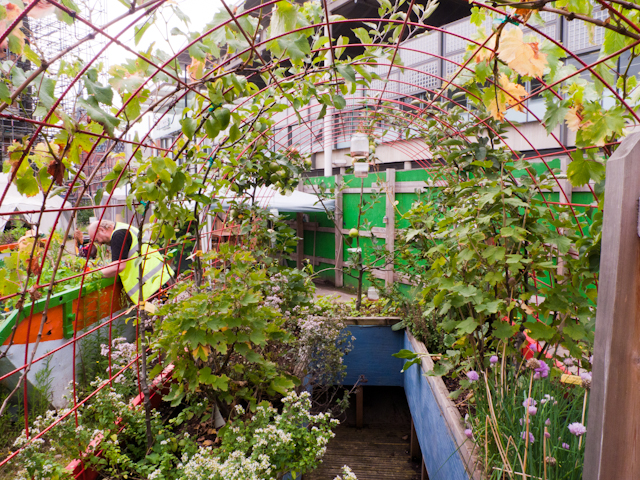“After the Olympic Park, this is the biggest building site in London”, says Paul Richens, the King’s Cross Skip Garden‘s enthusiastic and wonderfully knowledgeable gardener who shows me around – which is what makes the choice of location for this growing space so remarkable. The garden is located right inside the Kings Cross Central development, home to Eurostar, the new underground station, the nearly-finished University of the Arts campus and future-home to dozens of new office buildings and flats, the whole lot scheduled for completion by 2020. It is, as the name suggests, entirely constructed in a series of recycled skips, and designed to be a travelling garden, hoisted up and moved to new sites around the development as building work progresses.


Building work is in fact due to start at the garden’s current location on Pancras Road in the coming weeks, and it will shortly be re-housed at the other end of the building site on York Way. It will be interesting to see how its new location changes the feel of the space, which is heavily influenced by the juxtaposition of the station’s Gothic architecture, the Eurostar terminal’s metal and glass cladding, and the rubble of the building site, all visible from the garden and defining its very nature. With another 8 years to go before the site’s completion, there’s a real question mark over how, and more specifically, where, this garden may go next and what that will mean for its development and preservation.

Paul explains the garden’s design to me: each skip represents an element of a full-blown garden, so there is a poly-tunnel skip, an orchard skip, a root skip and so on, all powered by what he’s called the Green Engine – the skip housing an impressive wormery and huge tufts of Bocking 14 Comfrey, the organic gardener’s secret weapon when it comes to mulching and nourishing the earth. The skips aren’t just filled with earth, but instead contain wooden beds and a set of stairs down the centre of each one, so that the student gardeners who come along to help Paul maintain the site have easy access to all areas of the growing space. Educational workshops and talks take place in the garden’s “bio-dome”, the cosy tent space at the rear of the garden.


each skip contains one ton of soil, arranged in beds and accessed through a set of stairs


(left) Paul at work (right) the Green Engine


(left) the Orchard skip (right) the Eurostar terminal overshadows the garden


(left) tumbling alpine strawberries mark their territory (right) the view from the educational tent

The project is an initiative of Global Generation, an award-winning organisation that provides young people with opportunities to get involved in environmental and sustainable projects, under the themes of “I, We and the Planet”, and has been heavily supported by the Guardian, Camden Council, Capital Growth and Big Lottery.






























